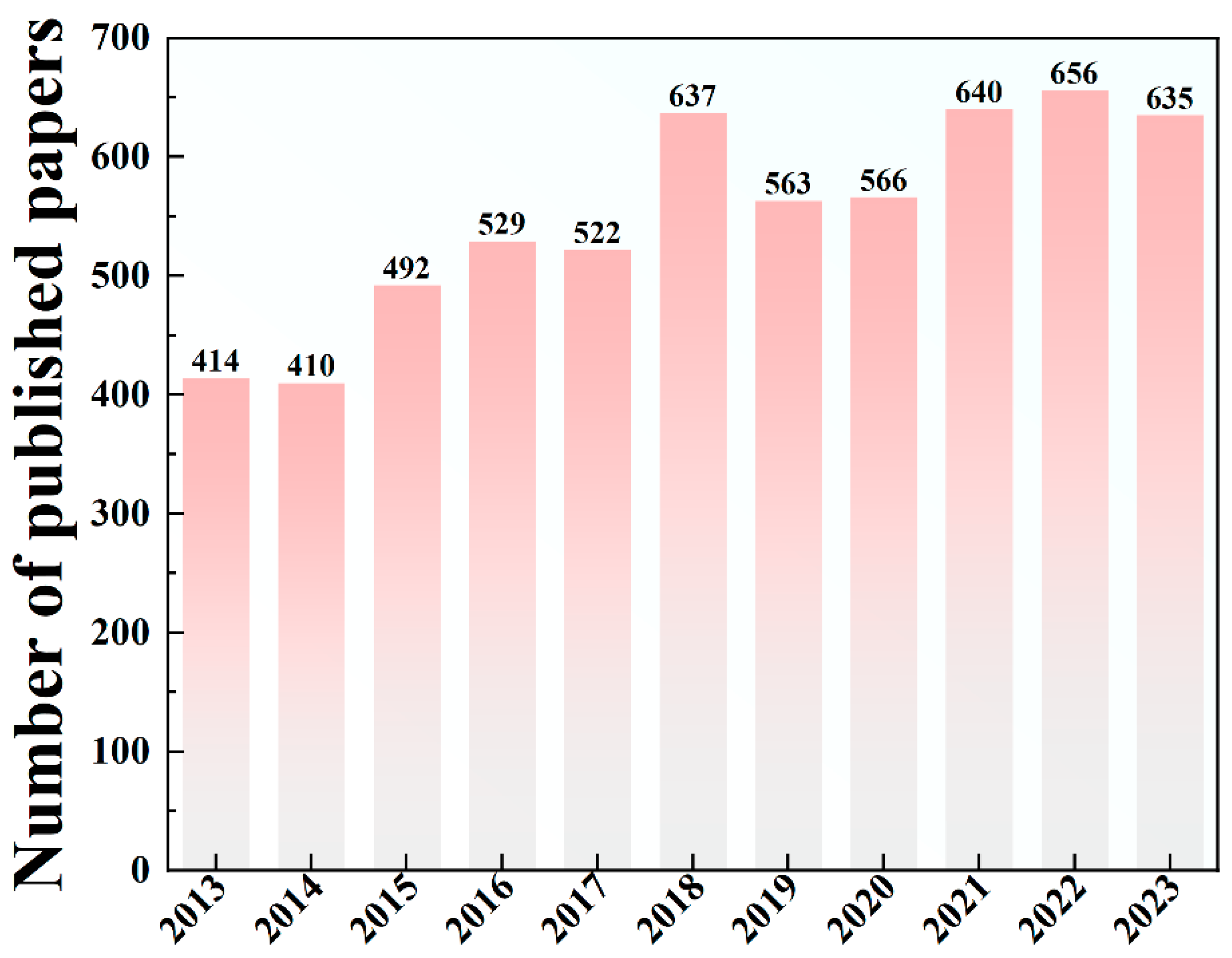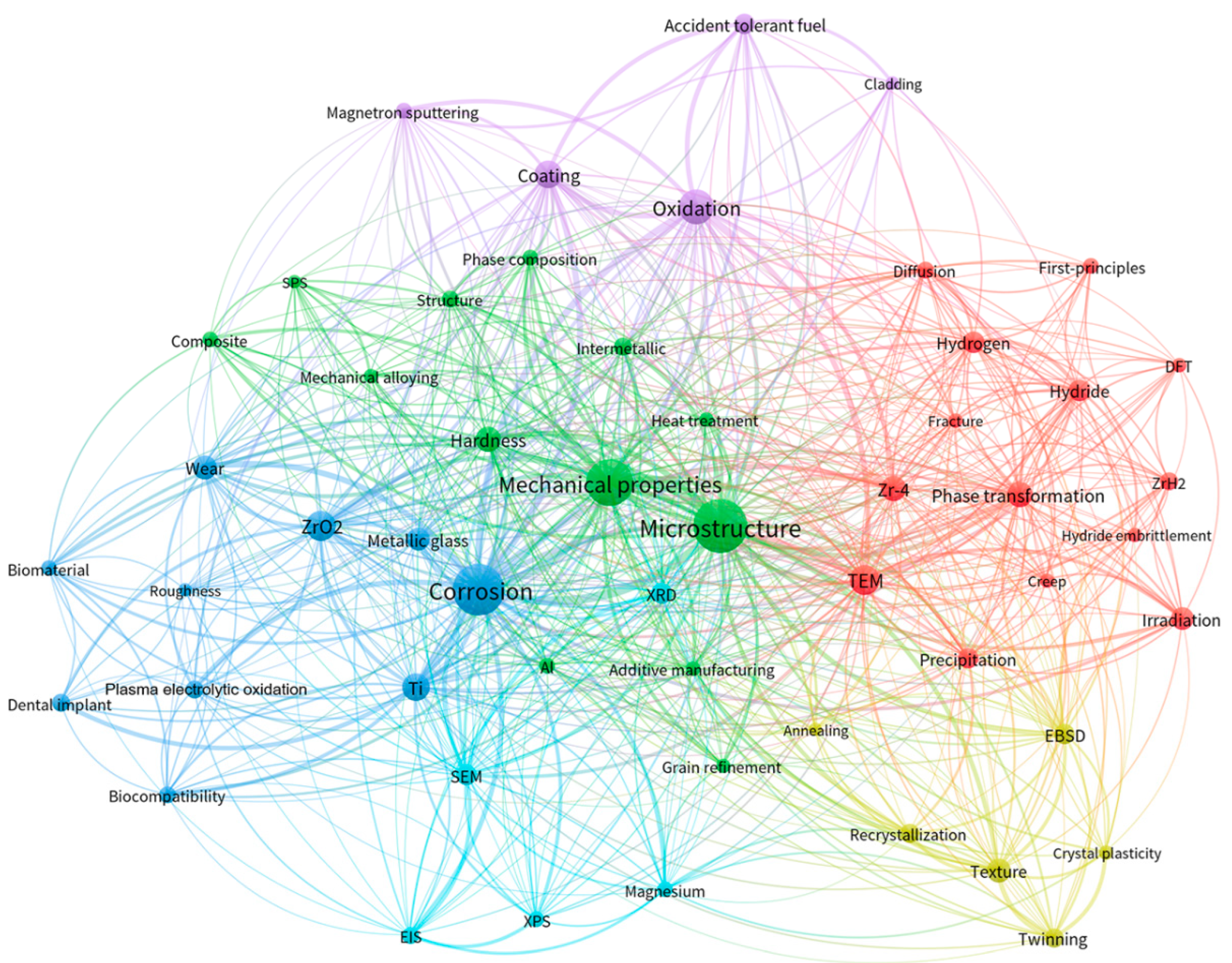Advances in Zr-Based Alloys
Author Contributions
Conflicts of Interest
References
- Li, C.; Tan, J.; Zhu, X.; Zhang, Y.; Stoica, M.; Kühn, U.; Eckert, J. On the transformation-induced work-hardening behavior of Zr47.5Co47.5Al5 ultrafine-grained alloy. Intermetallics 2013, 35, 116–119. [Google Scholar] [CrossRef]
- Li, C.; Tan, J.; Wang, G.; Bednarčík, J.; Zhu, X.; Zhang, Y.; Stoica, M.; Kühn, U.; Eckert, J. Enhanced strength and transformation-induced plasticity in rapidly solidified Zr–Co–(Al) alloys. Scr. Mater. 2013, 68, 897–900. [Google Scholar] [CrossRef]
- Zhong, L.; Feng, Z.; Zhao, S.; Tan, J.; Li, C.; Yi, J.; Eckert, J. Effect of stacking fault energy on B2 ZrCo phase transition and nanotwins formation in Zr54.5Co33.5Al12 alloy prepared by rapid solidification. Vacuum 2024, 221, 112890. [Google Scholar] [CrossRef]
- Zhou, Y.; Tian, W.; Dong, Q.; Wang, H.; Zhang, J.; Tan, J. First-principles calculations to investigate mechanical, electronic, optical, and thermodynamic properties of Zr-based ternary compounds. J. Mater. Res. Technol. 2023, 23, 1417–1434. [Google Scholar] [CrossRef]
- Wang, H.; Zhou, Y.; Dai, L.; Mi, X.; Sun, C.; Dong, Q.; Wu, L.; Tan, J.; Tang, A. Interaction of displacement cascades with {10–12} and {10–11} twin boundaries in zirconium: A molecular dynamic study. J. Mater. Res. Technol. 2023, 27, 3362–3373. [Google Scholar] [CrossRef]
- Wang, H.; Qin, C.; Zhou, Y.; Mi, X.; Wang, Y.; Kang, J.; Pan, R.; Wu, L.; She, J.; Tan, J.; et al. Interaction between collision cascades and nanocrack in hcp zirconium by molecular dynamics simulations. Comput. Mater. Sci. 2022, 214, 111688. [Google Scholar] [CrossRef]
- Duan, Z.; Yang, H.; Satoh, Y.; Murakami, K.; Kano, S.; Zhao, Z.; Shen, J.; Abe, H. Current status of materials development of nuclear fuel cladding tubes for light water reactors. Nucl. Eng. Des. 2017, 316, 131–150. [Google Scholar] [CrossRef]
- Azevedo, C. Selection of fuel cladding material for nuclear fission reactors. Eng. Fail. Anal. 2011, 18, 1943–1962. [Google Scholar] [CrossRef]
- Yan, C.; Wang, R.; Wang, Y.; Wang, X.; Bai, G. Effects of ion irradiation on microstructure and properties of zirconium alloys—A review. Nucl. Eng. Technol. 2015, 47, 323–331. [Google Scholar] [CrossRef]
- Stoll, U.; Slavinskaya, N. Corrosion behavior of zirconium alloys in the aqueous environment. Phenomenological aspects. Overview. J. Nucl. Sci. Technol. 2023, 60, 573–602. [Google Scholar] [CrossRef]
- Kautz, E.; Gwalani, B.; Yu, Z.; Varga, T.; Geelhood, K.; Devaraj, A.; Senor, D. Investigating zirconium alloy corrosion with advanced experimental techniques: A review. J. Nucl. Mater. 2023, 585, 154586. [Google Scholar] [CrossRef]
- Jiang, G.; Xu, D.; Yang, W.; Liu, L.; Zhi, Y.; Yang, J. High-temperature corrosion of Zr–Nb alloy for nuclear structural materials. Prog. Nucl. Energy 2022, 154, 104490. [Google Scholar] [CrossRef]
- Jiang, G.; Xu, D.; Liu, J.; Yang, J.; Li, Y.; Kuang, W. Corrosion protection and failure mechanism of ZrO2 coating on zirconium alloy Zry-4 under varied LiOH concentrations in lithiated water at 360 °C/18.5 MPa. Appl. Surf. Sci. 2023, 650, 159173. [Google Scholar] [CrossRef]
- Zhang, Y.N.; Yang, H.L.; Juaim, A.N.; Chen, X.N.; Chang, L.U.; Ling, Z.O.U.; Wang, Y.Z.; Zhou, X.W. Biocompatibility and osteogenic activity of Zr−30Ta and Zr−25Ta−5Ti sintered alloys for dental and orthopedic implants. Trans. Nonferrous Met. Soc. China 2023, 33, 851–864. [Google Scholar] [CrossRef]
- Tang, J.; Yang, H.; Qian, B.; Zheng, Y.; Vermaut, P.; Prima, F.; Sun, F. TWIP-assisted Zr alloys for medical applications: Design strategy, mechanical properties and first biocompatibility assessment. J. Mater. Sci. Technol. 2024, 184, 32–42. [Google Scholar] [CrossRef]
- Byeli, A.; Kukareko, V.; Kononov, A. Titanium and zirconium based alloys modified by intensive plastic deformation and nitrogen ion implantation for biocompatible implants. J. Mech. Behav. Biomed. Mater. 2012, 6, 89–94. [Google Scholar] [CrossRef]
- Adamson, R.B.; Coleman, C.E.; Griffiths, M. Irradiation creep and growth of zirconium alloys: A critical review. J. Nucl. Mater. 2019, 521, 167–244. [Google Scholar] [CrossRef]
- Yang, Y.; Xiong, X.; Chen, J.; Peng, X.; Chen, D.; Pan, F. Research advances in magnesium and magnesium alloys worldwide in 2020. J. Magnes. Alloys 2021, 9, 705–747. [Google Scholar] [CrossRef]
- Song, J.; Chen, J.; Xiong, X.; Peng, X.; Chen, D.; Pan, F. Research advances of magnesium and magnesium alloys worldwide in 2021. J. Magnes. Alloys 2022, 10, 863–898. [Google Scholar] [CrossRef]
- Yang, Y.; Xiong, X.; Chen, J.; Peng, X.; Chen, D.; Pan, F. Research advances of magnesium and magnesium alloys worldwide in 2022. J. Magnes. Alloys 2023, 11, 2611–2654. [Google Scholar] [CrossRef]
- Yan, J.; Wang, X.; Wang, Q.; Sun, X. Novel MRI-compatible Zr–Mo–Nb alloys with superior mechanical performance, high corrosion resistance and good cytocompatibility for biomedical applications. J. Mater. Res. Technol. 2024, 30, 794–806. [Google Scholar] [CrossRef]
- Suyalatu; Kondo, R.; Tsutsumi, Y.; Doi, H.; Nomura, N.; Hanawa, T. Effects of phase constitution on magnetic susceptibility and mechanical properties of Zr-rich Zr–Mo alloys. Acta Biomater. 2011, 7, 4259–4266. [Google Scholar] [CrossRef]
- Kondo, R.; Nomura, N.; Suyalatu; Tsutsumi, Y.; Doi, H.; Hanawa, T. Microstructure and mechanical properties of as-cast Zr–Nb alloys. Acta Biomater. 2011, 7, 4278–4284. [Google Scholar] [CrossRef]
- Nie, L.; Zhan, Y.; Liu, H.; Tang, C. In situ synthesized low modulus biomedical Zr-4Cu-xNb alloys. Mater. Sci. Eng. C 2013, 33, 5105–5108. [Google Scholar] [CrossRef]
- Zhan, Y.; Li, C.; Jiang, W. β-type Ti-10Mo-1.25Si-xZr biomaterials for applications in hard tissue replacements. Mater. Sci. Eng. C 2012, 32, 1664–1668. [Google Scholar] [CrossRef]
- Zhang, X.; Zhang, B.; Liu, S.; Xia, C.; Ma, M.; Liu, R. Microstructures and mechanical properties of Zr–Al binary alloys processed by hot-rolling. Mater. Sci. Eng. A 2020, 773, 138723. [Google Scholar] [CrossRef]
- Sun, X.; Liu, D.; Zhou, W.; Nomura, N.; Doi, H.; Tsutsumi, Y.; Hanawa, T. Effects of quenching process on microstructure, mechanical properties and magnetic susceptibility in Zr 1Mo alloy fabricated by powder bed fusion process. Mater. Des. 2020, 187, 108356. [Google Scholar] [CrossRef]
- Wang, K.; Yin, R.; Xu, X.; Wei, W.; Tian, Y.; Deng, Z.; Zhang, L.; Liu, L. A study of mechanical and magnetic properties in a metastable Zr–10Nb–6Sn alloy for MRI-compatible hard tissue replacements. J. Mater. Res. Technol. 2024, 29, 2959–2970. [Google Scholar] [CrossRef]
- Wu, Z.; Lu, W.; Li, C.; Gao, P.; You, X.; Tan, J. Effect of Al Content on the Microstructure and Tensile Properties of Zr-Co-Al Alloy Prepared by Rapid Solidification. Crystals 2022, 12, 1483. [Google Scholar] [CrossRef]
- Liu, Y.; Chen, K.; Song, T.; Chen, B.; Li, Q.; Xia, C. Improvement of Mechanical Properties for a Novel Zr–Ti–V Alloy via Hot-Rolling and Annealing Treatment. Crystals 2022, 12, 1765. [Google Scholar] [CrossRef]
- Sun, H.; Zhang, Y.; Sun, C.; Li, B.; Zhu, X.; Sun, Y.; Luan, B. Quasi-In Situ EBSD Study of Anisotropic Mechanical Behavior and Associated Microstructure Evolution in Zircaloy-4. Crystals 2022, 12, 1489. [Google Scholar] [CrossRef]
- Syrtanov, M.; Kashkarov, E.; Abdulmenova, A.; Sidelev, D. High-temperature oxidation of Zr 1Nb zirconium alloy with protective Cr/Mo coating. Surf. Coat. Technol. 2022, 439, 128459. [Google Scholar] [CrossRef]
- Kashkarov, E.; Sidelev, D.; Pushilina, N.; Yang, J.; Tang, C.; Steinbrueck, M. Influence of coating parameters on oxidation behavior of Cr-coated zirconium alloy for accident tolerant fuel claddings. Corros. Sci. 2022, 203, 110359. [Google Scholar] [CrossRef]
- Kuprin, A.S.; Belous, V.A.; Voyevodin, V.N.; Bryk, V.V.; Vasilenko, R.L.; Ovcharenko, V.D.; Reshetnyak, E.N.; Tolmachova, G.N.; V’Yugov, P.N. Vacuum-arc chromium-based coatings for protection of zirconium alloys from the high-temperature oxidation in air. J. Nucl. Mater. 2015, 465, 400–406. [Google Scholar] [CrossRef]
- Zhu, H.; Liu, H.; Zhou, J.; Dong, Y.; Li, P.; Chen, L.; Yi, J.; Huang, Q.; Huang, F.; Ge, F. Long-term oxidation resistance and deterioration mechanism of magnetron sputtered Cr-Al-Si-N coatings on zirconium alloys in 1200 °C steam atmosphere. Corros. Sci. 2020, 171, 108603. [Google Scholar] [CrossRef]
- Brachet, J.-C.; Idarraga-Trujillo, I.; Le Flem, M.; Le Saux, M.; Vandenberghe, V.; Urvoy, S.; Rouesne, E.; Guilbert, T.; Toffolon-Masclet, C.; Tupin, M.; et al. Early studies on Cr-Coated Zircaloy-4 as enhanced accident tolerant nuclear fuel claddings for light water reactors. J. Nucl. Mater. 2019, 517, 268–285. [Google Scholar] [CrossRef]
- Wen, L.; Li, Q.; Yang, B.; Yang, Z.; Wang, J.; Song, P. Oxidation Behavior of FeCoNiCrMo High-Entropy Coatings by Atmospheric Plasma Spraying on Zircaloy-4 in Steam at 1100 °C. Crystals 2022, 12, 1529. [Google Scholar] [CrossRef]
- Kahrobaee, Z.; Rashkova, B.; Hauschildt, K.; Palm, M. Experimental Investigation of Phase Equilibria in the Ti–Al–Zr System at 1000–1300 °C. Crystals 2022, 12, 1184. [Google Scholar] [CrossRef]
- Kong, X.; Wang, Q.; Yu, Y.; Shen, Y.; Zhang, C.; Pan, R.; Kharchenko, D.O.; Mao, J.; Ning, Z.; Fang, Z.; et al. Effect of solute Nb and Sn on self-interstitial atom defect in zirconium-based alloys by first-principles calculations. J. Nucl. Mater. 2024, 588, 154795. [Google Scholar] [CrossRef]
- Christensen, M.; Wolf, W.; Freeman, C.; Wimmer, E.; Adamson, R.; Hallstadius, L.; Cantonwine, P.; Mader, E. Effect of alloying elements on the properties of Zr and the Zr–H system. J. Nucl. Mater. 2014, 445, 241–250. [Google Scholar] [CrossRef]
- Samolyuk, G.; Barashev, A.; Golubov, S.; Osetsky, Y.; Stoller, R. Analysis of the anisotropy of point defect diffusion in hcp Zr. Acta Mater. 2014, 78, 173–180. [Google Scholar] [CrossRef]
- Dai, C.; Saidi, P.; Yao, Z.; Daymond, M.R. Atomistic simulations of Ni segregation to irradiation induced dislocation loops in Zr-Ni alloys. Acta Mater. 2017, 140, 56–66. [Google Scholar] [CrossRef]
- Wu, L.; Kharchenko, V.O.; Kong, X.; Kharchenko, D.O. First-principle calculations of vacancy clustering in zirconium-based alloys. J. Nucl. Mater. 2021, 554, 153079. [Google Scholar] [CrossRef]
- Pan, R.; Tang, A.; Qin, J.; Xin, T.; Wu, X.; Wen, B.; Wu, L. Trapping Capability of Small Vacancy Clusters in the α-Zr Doped with Alloying Elements: A First-Principles Study. Crystals 2022, 12, 997. [Google Scholar] [CrossRef]
- Borik, M.A.; Kulebyakin, A.V.; Myzina, V.A.; Lomonova, E.E.; Milovich, F.O.; Ryabochkina, P.A.; Sidorova, N.V.; Shulga, N.Y.; Tabachkova, N.Y. Mechanical characteristics, structure, and phase stability of tetragonal crystals of ZrO2–Y2O3 solid solutions doped with cerium and neodymium oxides. J. Phys. Chem. Solids 2021, 150, 109808. [Google Scholar] [CrossRef]
- Han, J.; Göksel, B.; Li, M.; Vleugels, J.; Braem, A.; Castagne, S. Effects of femtosecond laser surface texturing on mechanical properties and low temperature degradation of alumina toughened zirconia. J. Eur. Ceram. Soc. 2024, 44, 4196–4209. [Google Scholar] [CrossRef]
- Pereira, R.M.; Campos, T.M.B.; Bonfante, E.A.; Thim, G.P. A comparative study of mechanical properties of yttria stabilized zirconia monolithic and bilayer configuration for dental application. J. Mech. Behav. Biomed. Mater. 2023, 148, 106160. [Google Scholar] [CrossRef]
- Kohal, R.; Wolkewitz, M.; Mueller, C. Alumina-reinforced zirconia implants: Survival rate and fracture strength in a masticatory simulation trial. Clin. Oral Implants Res. 2010, 21, 1345–1352. [Google Scholar] [CrossRef]
- Schierano, G.; Mussano, F.; Faga, M.G.; Menicucci, G.; Manzella, C.; Sabione, C.; Genova, T.; von Degerfeld, M.M.; Peirone, B.; Cassenti, A.; et al. An Alumina Toughened Zirconia Composite for Dental Implant Application: In Vivo Animal Results. BioMed Res. Int. 2015, 2015, 157360. [Google Scholar] [CrossRef]
- Borik, M.A.; Kulebyakin, A.V.; Lomonova, E.E.; Milovich, F.O.; Myzina, V.A.; Ryabochkina, P.A.; Tabachkova, N.Y.; Sidorova, N.V.; Chislov, A.S. Partially Yttria-Stabilized Zirconia Crystals Co-Doped with Neodymium, Cerium, Terbium, Erbium or Ytterbium Oxides. Crystals 2021, 11, 1587. [Google Scholar] [CrossRef]


Disclaimer/Publisher’s Note: The statements, opinions and data contained in all publications are solely those of the individual author(s) and contributor(s) and not of MDPI and/or the editor(s). MDPI and/or the editor(s) disclaim responsibility for any injury to people or property resulting from any ideas, methods, instructions or products referred to in the content. |
© 2024 by the authors. Licensee MDPI, Basel, Switzerland. This article is an open access article distributed under the terms and conditions of the Creative Commons Attribution (CC BY) license (https://creativecommons.org/licenses/by/4.0/).
Share and Cite
Dong, Q.; Tan, J. Advances in Zr-Based Alloys. Crystals 2024, 14, 351. https://doi.org/10.3390/cryst14040351
Dong Q, Tan J. Advances in Zr-Based Alloys. Crystals. 2024; 14(4):351. https://doi.org/10.3390/cryst14040351
Chicago/Turabian StyleDong, Quan, and Jun Tan. 2024. "Advances in Zr-Based Alloys" Crystals 14, no. 4: 351. https://doi.org/10.3390/cryst14040351
APA StyleDong, Q., & Tan, J. (2024). Advances in Zr-Based Alloys. Crystals, 14(4), 351. https://doi.org/10.3390/cryst14040351





